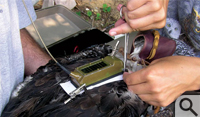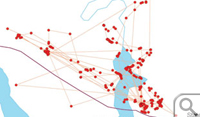The Eagle Trappers
Researchers try to keep the national bird out of harm's way at the Aberdeen Proving Ground
Aberdeen Proving Ground, up at the head of the Chesapeake Bay, is a busy place.
Since 1918, U.S. armed forces have used the 114-square-mile facility for testing new equipment and ordnance from helmets to tanks. In recent years, the nation's armed forces have had to share the facility with a growing population of the nation's bird.
Aberdeen is a magnet for bald eagles, according to Bryan Watts, director of William and Mary's Center for Conservation Biology, but it's a dangerous one. Watts is leading a group of  researchers investigating issues surrounding accidental deaths of eagles at Aberdeen. Based on the use of high-tech GPS technology, the research will not only help the bird colonels and bald eagles coexist on Aberdeen, but also will contribute to the general knowledge of daily movement patterns and seasonal migration of eagles.
researchers investigating issues surrounding accidental deaths of eagles at Aberdeen. Based on the use of high-tech GPS technology, the research will not only help the bird colonels and bald eagles coexist on Aberdeen, but also will contribute to the general knowledge of daily movement patterns and seasonal migration of eagles.
Several spots on the Bay along its major tributaries tend to attract breeding eagles. Aberdeen is one of those spots, but it draws more eagles than just those looking for a place to nest.
"Aberdeen probably supports more eagles than any federal property on the Atlantic coast," Watts said. “It's not just a breeding population. They have 40-some nests there and it's growing all the time, but in January we get northern birds."
Watts said the northern birds come down from an area that stretches from the Maritime Provinces of Canada and Maine and that probably extends through New York. Aberdeen is one of the places they congregate in big numbers. "We get the reverse of that in May," he said. "We get birds from Florida to South Carolina coming up and they spend the summer and leave in the early fall."
The northern and southern migrant populations hatch and raise their chicks in their own home ranges, Watts said. He has noticed communal roosts of migrant birds quite near nesting residents, surprising for eagles, which are territorial nesters and usually jealous of any intrusion, he said.
"This is the only place on the continent where you get a resident breeding population-with chicks-with an influx of migrants," Watts said. "These birds come in when our birds still have chicks in the nest. There's nowhere else where that occurs."
Dangerous landings
 Migrants and nesters seem to get along, he noted. Any troubles the eagles run into are man-made, not eagle-made. At Aberdeen Proving Ground, Watts said, eagles often run into trouble literally-colliding with electric lines. Other dangers to the eagles come from the nature of the place.
Migrants and nesters seem to get along, he noted. Any troubles the eagles run into are man-made, not eagle-made. At Aberdeen Proving Ground, Watts said, eagles often run into trouble literally-colliding with electric lines. Other dangers to the eagles come from the nature of the place.
"Up at Aberdeen, they shoot munitions all the time or they explode things and test them," Watts said. "So one of the concerns is how the activity of the tenants influences the mortality patterns and such. There is a long history of concern."
The military and the eagles can co-exist up on Aberdeen Proving Ground, Watts said, if the armed forces know how to accommodate the eagles' habits. Some of the infrastructure, particularly power lines, may need to be moved, he said, but rescheduling activities can be beneficial as well.
"If you know that the eagles leave their roosts on trees in the interior by 9 a.m. to go down to the shoreline to forage, you can postpone any operations you have in that area until 9:30 or after the eagles leave," he explained. It's a good idea in theory, but to put it into practice, you have to know how the eagles move.
This is where the Center for Conservation Biology comes in. Watts and his colleagues at the CCB are the "go-to" team for eagle research. Libby Mojica, a raptor specialist, is managing the project. She joined the CCB about a year ago, after completing her master's thesis on bald eagles.
"The master's work that I was doing at the University of Georgia was on migrating Florida eagles. A lot of them come up to the Aberdeen Proving Ground and spend the summer there," she said. "This job specifically appealed to me because now I'm working with those same birds and the local birds and the northern birds and how they all interact on base."
Flying with a payload
 For the Aberdeen project, Mojica and her team brought in some ordnance of their own in the form of a set of eagle-sized solar-powered GPS backpacks.
For the Aberdeen project, Mojica and her team brought in some ordnance of their own in the form of a set of eagle-sized solar-powered GPS backpacks.
"These units are fantastic," Watts said. "They're expensive-they cost about $4,000 apiece and the satellite time to track a bird is about $2,000 a year. So for the first year, it's about $6,000 a bird, but there's no other way to get that data."
Each GPS unit is programmed to send out a dozen or so fixes a day, so the researchers can pinpoint the location of the eagle, within a meter, roughly every hour of the bird's waking day and a couple times during the bird's sleep period. Technically, the GPS units can give altitude, as well, providing researchers with a three-dimensional fix to indicate if the bird is roosting, on the ground or in the air. However, the researchers chose to sacrifice the altitude function in order to get a larger number of two-dimensional fixes on each bird. Watts said his team intends to equip 64 birds with the backpacks, a deployment that will generate more than 900 fixes a day. The target population is resident adult eagles.
"These Aberdeen birds are resident year-round, so they're going to give you the most local data," Watts said. "And then we want to put a certain portion of the units on the northern migrants and a certain portion on the southern migrants. We're going to track how long the eagles stay on the installation to give us some idea of their vulnerability at Aberdeen."
To make sure the distribution of GPS units contains the desired mix of native, southern and Yankee eagles, it's important for the researchers to distinguish resident birds from migrants.
"That's turned out to be a little bit tricky. There's a latitudinal variation in body size, so the southern birds are quite a bit smaller," Watts said. "There's also sexual dimorphism in size-the males are about 30 percent smaller than females. When we're out doing surveys and you see a little male, it looks more like a red-tailed hawk size. When I was an undergrad working up at Pautuxent, we had a little southern male we named Pee-Wee. Just a tiny little thing."
Northern eagles are larger
In turn, the northern eagles run quite a bit larger than the Chesapeake Bay native birds, he said, but there is enough individual variation in size to make for a frustrating amount of overlap. "We have difficulty telling, for example, the northern males from our birds here," Watts said. "The same thing goes for our birds versus the southern females."
Watts' earlier research leads him to suspect that a substantial portion of the birds that die at Aberdeen are from one of the migrant populations. "There is a peak in the mortality during the May-June period, which suggests that it might be more skewed toward southern birds," he said. "So is it these newly arriving birds that are more likely to run into things because they don't know what the infrastructure is? You would think that the resident birds are familiar enough with the hazards that they wouldn't be at risk."
Eagle researchers have been working at Aberdeen for years, but analysis of data from the movement of birds bearing the GPS backpacks will add a needed new dimension. "We know how many birds are up there from year to year, but we don't know how many individual birds that represents," Watts said. "This gives us an idea of what the turnover rates are like, so we can figure how many total birds are using that piece of land."
The primary objective of the research is to generate recommendations for making Aberdeen more eagle-friendly, but the data collected also will add to the CCB's understanding of how the Chesapeake Bay's populations of our national bird-resident and visitor-roam, migrate and live out their days. Mojica said the GPS tracking may help answer a number of questions about eagle interaction."
"We know that northern adults migrate, but we really don't know if the adults in the southern population migrate," she said. "The eagles we know to be southern birds at Aberdeen are juveniles."
The Center for Conservation Biology has served as "eagle central" on the Atlantic Coast for decades. Watts and other researchers conduct seasonal aerial census flights along the shoreline of Virginia's portion of the Chesapeake Bay and its tributaries and will be conducting similar flights in North Carolina. The CCB will soon start a study on depositional mercury in eagles in the Virginia Piedmont.
Watts also has been doing eagle research at Indian Head naval base, in Maryland on the Potomac River, a site with "an incredible density of eagles-ten nests on a little piece of ground not more than a couple hundred acres." This spring, he and his associates will be climbing the big hardwood trees of Indian Head to take blood samples from eagle chicks still in the nest.
The CCB researchers have 64 GPS backpacks to fit on the eagles at Aberdeen. As of early March, they were exactly halfway finished, with 32 more eagles to trap at Aberdeen. As if trapping and subduing bald eagles doesn't generate enough thrills, working on a military munitions testing ground can provide an additional dose of excitement. Mojica remembers one winter day when a car pulled up just as the team had secured two eagles. A military contractor jumped out and told the researchers that a test firing was imminent and that they were on the edge of a danger zone. The team needed to evacuate immediately.
The contractor offered Mojica a ride out of the danger zone. She hopped in the car, cradling in her arms a newly caught specimen of the national bird, bound and hooded, but still very much wild. "I don't think he knew what we were doing when he drove up to our site," she said. "He kept on looking over as he was driving. He was just ecstatic to have an eagle in his car." 















